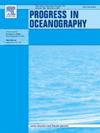中浮游动物群落:西南大西洋热带地区的结构、功能和食物供应
IF 3.6
3区 地球科学
Q1 OCEANOGRAPHY
引用次数: 0
摘要
我们研究了西南大西洋热带地区中浮游动物群落的分类和功能复杂性以及相关的营养关系。中浮游动物群落在沿海和海洋之间分布明显。沿大陆架,受弗里奥角上升流和Paraíba do Sul河羽流影响的地区,其生产力和养分有效性高,中浮游动物丰度最高。中小型浮游动物以当前摄食和广播产卵为特征,在种群中占主导地位。微小浮游生物和微小浮游生物是水流摄食组丰度的关键预测因子。对于巡航/伏击摄食组,悬浮颗粒物和自养小浮游生物是其丰度的重要预测因子。伏击摄食组主要受水流摄食和巡航/伏击摄食组以及悬浮颗粒物的影响。这项研究提供了对南大西洋浮游动物群落功能群的见解,并解决了我们对南大西洋西部大部分海洋食物网基础相互作用的理解中的一个显着空白。这些信息对于了解全球气候变化和局部扰动对该地区海洋营养动态的潜在影响至关重要。本文章由计算机程序翻译,如有差异,请以英文原文为准。
Mesozooplankton community: Structure, functionality, and food availability in a tropical area of the Southwest Atlantic Ocean
We investigated the taxonomic and functional complexity of a mesozooplankton community and associated trophic relationships in a tropical area of the Southwest Atlantic Ocean. Mesozooplankton communities showed a clear distribution between coastal and oceanic regions. Along the continental shelf, areas influenced by the upwelling of the Cabo Frio and plume of the Paraíba do Sul River, characterized by high productivity and nutrient availability, showed the highest abundance of mesozooplankton. Small-to-medium-sized mesozooplankton species, characterized by current feeding and a broadcast spawning strategy, were dominant over other species. Picoplankton and microplankton were found to be key predictors of the abundance of current-feeding group. For cruise/ambush–feeding group, suspended particulate matter and autotrophic microplankton were significant predictors of their abundance. Ambush-feeding group is primarily influenced by the availability of current-feeding and cruise/ambush–feeding groups and suspended particulate matter. This study provides insights into the functional groups of the zooplankton community in the South Atlantic Ocean and addresses a notable gap in our understanding of interactions at the base of the marine food web across much of the western South Atlantic Ocean. This information is crucial for understanding the potential impacts of global climate change and local disturbances on marine trophic dynamics in the region.
求助全文
通过发布文献求助,成功后即可免费获取论文全文。
去求助
来源期刊

Progress in Oceanography
地学-海洋学
CiteScore
7.20
自引率
4.90%
发文量
138
审稿时长
3 months
期刊介绍:
Progress in Oceanography publishes the longer, more comprehensive papers that most oceanographers feel are necessary, on occasion, to do justice to their work. Contributions are generally either a review of an aspect of oceanography or a treatise on an expanding oceanographic subject. The articles cover the entire spectrum of disciplines within the science of oceanography. Occasionally volumes are devoted to collections of papers and conference proceedings of exceptional interest. Essential reading for all oceanographers.
 求助内容:
求助内容: 应助结果提醒方式:
应助结果提醒方式:


